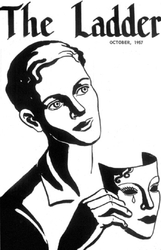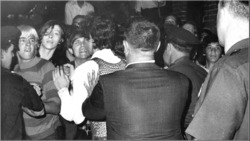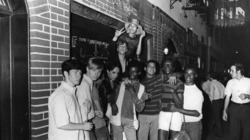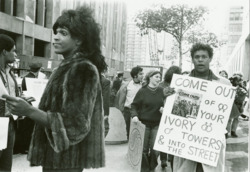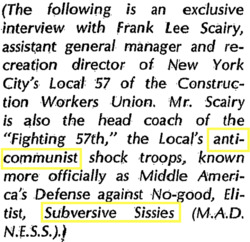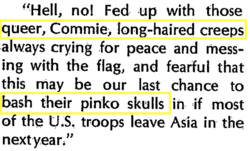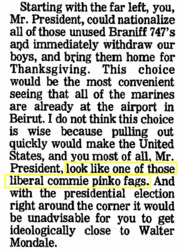"Pinko Commie"
The Liberated Left?
It would appear that the rise of LGBTQ+ centered activism at Union College began later than the national rise of such movements. The phrase "homophile" does not appear in the Concordiensis even once in the window when the homophile movement arose in the 1950s and 1960s. The Concordiensis, or any other campus publication, do not make any reference to the Stonewall Uprising of 1969. It is worth noting that Stonewall occurred in late June and early July, when school would have been out of session, but even in the subsequent fall term, nothing about Stonewall or gay liberation in general made its way into campus publications.
It would be irresponsible to assume that because the homophile movement and the Stonewall Uprising don't appear in official campus literature, students, staff, and faculty didn't react to, or play a part in, subsequent activism that occurred across the nation. Out of necessity, queer history has always involved the formation of covert and underground networks, organizations, and methods of communication.
However, it is important to note that the late 1960s and early 1970s were tumultous times on Union's campus, as was the case with many colleges and universities during an era of mass student protests. Anti-ROTC and anti-Vietnam War protests, as well as protests for racial justice that were born out of the Civil Rights Movement, are well-documented in our archives. A leftist student publication, the Union Press, printed several editions in 1970, and classes were even canceled by the administration in the aftermath of the Kent State University shooting to allow Union students to participate in protests and canvassing in the Schenectady area [1].
A black and white photograph of members of the Mattachine Society, an early national gay rights organization that was founded in 1950. Their name refers to "unmasking."
The only known photograph from the first night of the Stonewall uprising, taken June 28, 1969. The photograph is a black and white image of a group of protestors attempting to impede four policemen, who were conducting a raid on the gay bar the Stonewall Inn.
A black and white photograph of a group of young adults celebrating in the aftermath of the Stonewall Uprising, which came to an end on July 3, 1969. They are standing outside of the boarded up Stonewall Inn.
A black and white photograph of Marsha P. Johnson, a Black trans woman and prolific activist who played a vital role in the Stonewall Uprising and the founding of the Gay Liberation Front. She is pictured handing out fliers on the street to people in support of LGBTQ+ students at New York University, and protestors can be seen behind her.
The spirit of youth counterculture that overtook the world from approximately 1968 to 1972 clearly came to Union College - yet protests or other forms of activism focused explicitly on LGBTQ+ rights do not appear to have taken place, even in leftist, progressive, and activist spaces on campus. This exclusion of LGBTQ+ activism from progressive spaces has historical precedence:
I could imagine these comrades, Black and white, among whom color and racial differences could be openly examined and talked about, nonetheless one day asking me accusingly, 'Are you or have you ever been a member of a homosexual relationship' [2]?
At the very least, even if there was some sort of LGBTQ+ centered activism at Union during the era of mass protest, they have not taken up any space in our institutional memory.
Despite the apparent dearth of LGBTQ+ centered activism on campus during the era of protest, leftists and LGBTQ+ people were still often conflated.
The Lavender Scare, while lesser known, accompanied the Red Scare of the 1950s and left a reverberating, lasting legacy. In the decades to follow, there was often an inextricable link drawn between leftism and queerness by those who were critical of leftist movements. Some gay rights organizations of the mid twentieth century, such as the Mattachine Society, had many members who were Communists, and some leftist spaces did explicitly advocate for LGBTQ+ rights, but the blanket conflation of the two was, of course, a vast oversimplification, but one that took a very strong and popular hold nonetheless.
You can't hardly separate homosexuals from subversives [3].
This longlasting conflation at Union, then, was a microcosm of wider public opinions and associations. Take a look at the following excerpts from the Concordiensis, dated in order: May 15, 1970; April 15, 1982; and November 3, 1983 [Content warning: use of slurs against gay men]. Highlights mine for emphasis.
Excerpt one from the Concordiensis article "Construction Workers and Students," published on May 15, 1970.
Transcription [my highlights in brackets]:
(The following is an exclusive interview with Frank Lee Scairy, assistant general manager and recreation director of New York City's Local 57 of the Construction Workers Union. Mr. Scairy is also the head coach of the "Fighting 57th," the Local's [ anti-communist ] shock troops, known more officially as Middle America's Defense against No-Good, Elitist, [ Subversive Sissies ] (M.A.D.N.E.S.S.))
Excerpt two from "Construction Workers and Students."
Transcription [my highlights in brackets]:
"Hell, no! Fed up with those [ queer, Commie, long-haired creeps ] always crying for peace and messing with the flag, and fearful that this may be our last chance to [ bash their pinko skulls ] in if most of the U.S. troops leave Asia in the next year."
Excerpt three from "Construction Workers and Students."
Reparative Transcription [my highlights in brackets]:
"it's simply one-on-one, patriot vs. [ Commie ], either the 'Fontanino [ [f-slur] Flattener' ] or the 'Hair Today, Gone Tomorrow' can be used most effectively. The 'Flattener,' named after ex-Ranger great Lou Fontinato, is comprised of [ grabbing a long-haired [shortened f-slur] ], pulling his shirt up over his head, rendering him defenseless, then busting up his ribs. 'Hair Today'
Excerpt from the Concordiensis article "Blame It On Union!," published on April 15, 1982.
Reparative Transcription [my highlights in brackets]:
"We must keep on fighting for the American way of life. Beware you [ commie, pinko [shortened f-slur]s ! ] There are still blue-blooded Americans ready to take you on.
Excerpt from the Concordiensis article "God Bless America," published on November 3, 1983.
Reparative Transcription [my highlights in brackets]:
Starting with the far left, you, Mr. President, could nationalize all of those unused Braniff 747's and immediately withdraw our boys, and bring them home for Thanksgiving. This choice would be the most convenient seeing that all of the marines are already at the airport in Beirut. I do not think this choice is wise because pulling out quickly would make the United States, and you most of all, Mr. President, [ look like one of those liberal commie pinko [shortened f slur]s ]. And with the presidential election right around the corner it would be unadvisable for you to get ideologically close to Walter Mondale.
One wonders if the campus leftist movements of the late 60s and early 70s knew of the deeply entrenched conflation of leftism and queerness, and if an attempt to challenge or avoid this stereotype is what left queer activism out of their otherwise intersectionality-based work.
[1] For more information on counterculture and protests at Union College, consult the "Student Protests" Picture File (SCA-1025), the "Student Protests" Vertical File (SCA-1026), the "Roger Stewart Collection of the 1970 National Student Strike" (SCA-1157), the "Robert Baker Papers" (SCA-1183), the "Harold C. Martin Collection" (RG-02-021), or the Encyclopedia of Union College History sections "The Campus Mood and the Computer Center" (pages 111-112) and "Vietnam War" (pages 765-770).
[2] A quote from Audre Lorde, a self-described "Black, lesbian, mother, warrior, poet," discussing her realization during the 1950s that the one taboo among antiracist and otherwise socially liberated leftists was homosexuality. Retrieved from Faderman, Lilly, Odd Girls and Twilight Lovers: A History of Lesbian Life in Twentieth Century America, 1991, page 144.
[3] A quote from Senator Kenneth Wherry of Nebraska (1943-1951) from 1950. Retrieved from Faderman, Odd Girls and Twilight Lovers, page 143.

